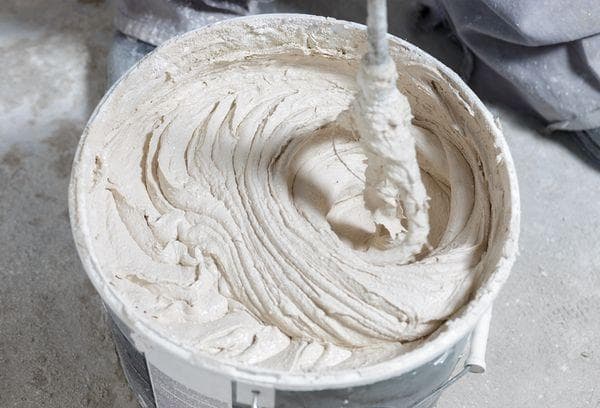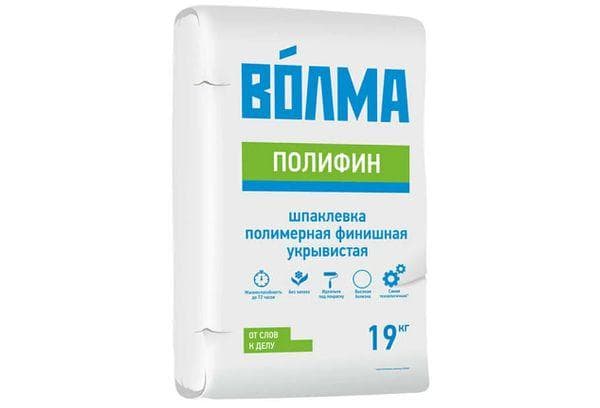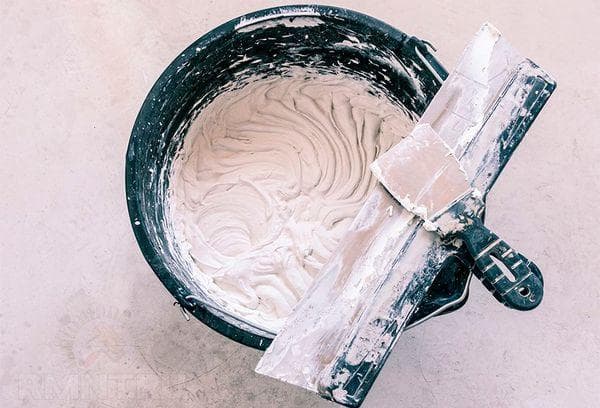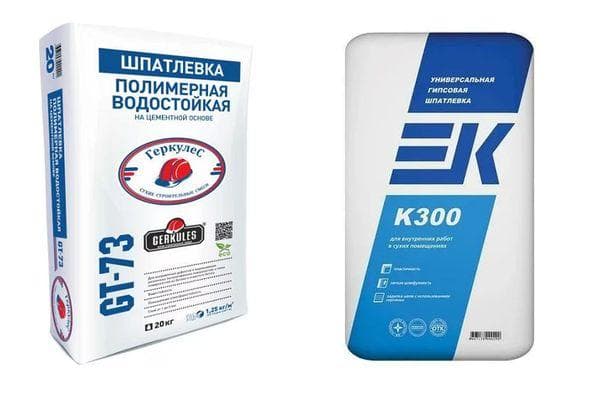Polymer putty or gypsum putty - which is better?
Content:
Any building material, including those intended for finishing, has its own characteristics, which it is better to familiarize yourself with in advance. You can determine which putty is better, gypsum or polymer, by studying their characteristics and comparing the advantages and disadvantages. When choosing, parameters such as strength, adhesion ability, base material, features of the finishing coating and some others are taken into account.
What is gypsum putty
Gypsum-based putty is a widely known building material intended for finishing premises. Such mixtures have proven themselves well, and their price remains affordable for buyers with any budget.
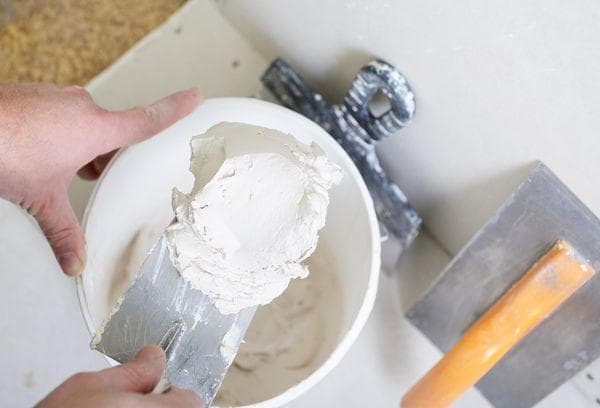
The product is used for both leveling and decorative finishing. Panels and stucco are made from gypsum. Buyers can purchase putty in the form of a dry mixture, which is then diluted with water, and an elastic paste, packaged in buckets.
When diluting yourself, you must strictly observe the proportions so that the putty gets exactly the consistency that is needed. The finished paste must be mixed thoroughly before application.The dry mixture is more often used if the surface of a large area is to be puttied; the composition must be diluted little by little, in parts, since it sets in a short time.
It is not worth stocking up on the material for future use; it has a limited shelf life (up to 1 year). When purchasing goods from Russian manufacturers, it is better to give preference to mixtures made in accordance with GOST. Among import companies, several brands have proven themselves well: Knauf, Yunis, Bergauf.
Types of gypsum putty
The basis of this putty is a natural mineral - gypsum, which belongs to the group of sulfates. Its color may vary depending on where it is mined. Manufacturers from Europe use raw materials of a perfectly snow-white shade. Putty made at Russian enterprises turns a little yellow. Gypsum can also be pinkish or gray. In Russia, the mineral is mined near Tula, in the Perm Territory and the Nizhny Novgorod region.
In its pure form, gypsum hardens in a few minutes. To prevent this from happening, plasticizing components and minerals are additionally introduced into the composition. Construction sand or finely ground marble is used as filler. Mixtures have different purposes:
- Starting. The mixture has a loose granular structure and is intended for leveling plaster and removing roughness. The final finishing is applied on top.
- Finish. The mixture consists of gypsum and finely ground marble. This putty has a homogeneous and plastic structure. Leveled surfaces can be painted immediately.
- Universal. Its composition occupies an intermediate position, since it contains medium-ground components.Suitable for surfaces with minimal defects and filling gaps between sheets of drywall.
It is important to apply the solution to the wall correctly. Professionals make smoothing movements from bottom to top. When leveling the ceiling, the putty is pulled towards itself.
What is polymer putty
Polymer-based putties appeared relatively recently. They are made from latex, acrylic, polymer cement. The solutions are characterized by increased plasticity, which allows them to be applied in the thinnest layer. After the composition hardens, a durable film is formed on the surface, resistant to external influences.
Putty paste is produced by mixing in special mixers (dissolvers). It is during the process of intensive mixing that the solution acquires a homogeneous elastic structure. Then the mass goes through the grinding stage.
Polymer putties are good because their properties and appearance are preserved for decades. The finishing material is expensive, but experts believe that it is the future. In addition to polymers, film-forming substances, chalk, and talc are added to the mixture. The composition of the putty is constantly being improved, resulting in an increase in its quality.
Types of polymer putties
Builders classify polymer putty according to its composition. Today there are 3 varieties:
- Acrylic. Can be used indoors and outdoors and is not afraid of moisture. The dried film is breathable and does not react to temperature changes. The solution must be stirred during application.
- Latex. The latex composition has plasticity, making it easy to apply. Latex putty is more suitable for covering walls in a residential area.Does not respond well to high humidity.
- Polymer cement. The solution, which is rough in structure, is intended to eliminate significant irregularities. Polymer cement can be laid in a layer up to 30 mm thick without an additional frame.
Polymer-based compositions have good adhesion, show low vapor permeability and good resistance to moisture. Finishing materials of this group are devoid of unpleasant odor and, after drying, are resistant to mechanical damage.
What is the difference?
First of all, the mixtures differ in composition. The main component of gypsum putty is gypsum. In polymer compositions, this role is played by polymer cement, acrylic or latex. Additionally, modifying and filling substances are added to both mixtures. The difference between gypsum putty is that it is more capricious. The material dries quickly when applied, it must be used in small portions.
Gypsum is not suitable for finishing kitchens and bathrooms due to the high level of humidity in these rooms. Polymer-based compositions are universal in this regard. Their properties do not deteriorate under the influence of moisture and temperature changes. Gypsum putty can be sold in the form of a ready-made paste and a dry mixture.
Polymer compositions are prepared in production and then packaged in plastic containers. Using them, you can start working right away. After the packaging is opened, the polymer putty remains suitable for application for 2-3 days. Gypsum-based compositions cannot be used for external work; acrylic mixtures or polymer cement are suitable for these purposes. Polymer materials are more expensive.
comparison table
| Plaster | Polymer | |
| Characteristics | Color – white or yellowish. Consumption – 0.6-2 kg/1 sq. m of leveled surface. The hardening time of the applied layer is from 45 minutes. The maximum application thickness is up to 5 mm. Filler fraction – 0.15-2 mm. Tensile strength – from 1 MPa. Compressive strength – from 2 MPa. | White color. Consumption – 0.5-2 kg/sq.m. m. area. Hardening time – 6-24 hours (depending on the type). The maximum application thickness is up to 30 mm (polymer cement). Filler fraction – 0.1-2 mm. Tensile strength – more than 2 MPa. Compressive strength – from 9 MPa. |
| Advantages | Environmentally friendly, high vapor permeability. It is easy to apply and sand, does not shrink, can be used without prior plastering, and is inexpensive. | High adhesion, good vapor permeability, ease of application, uniform drying, no deformation, resistance to mechanical stress, impeccable results. |
| Flaws | Not suitable for finishing rooms with high humidity. | High price. |
| Price | From 300 rubles for 20 kg of dry mixture. | Acrylic - from 300 rubles per 4.5 kg, latex - on average 400 rubles per 16 kg, polymer cement - 350 rubles per 20 kg of dry mixture. |
The cost of putty directly depends on the form of release, packaging, and manufacturer. When ordering online, the price increases due to delivery charges.
Pros and cons of gypsum putty
With the abundance of modern finishing materials, gypsum-based solutions are still in demand. Their popularity provides significant advantages:
- vapor permeability – gypsum absorbs excess moisture from the air, creating a favorable microclimate in the room;
- ease of application – thanks to its plastic structure, the solution is easy to apply even by a beginner, work can be carried out at high speed;
- environmental Safety – the material has a natural basis, therefore it does not pose a danger to the environment and humans;
- no shrinkage – the presence of modifiers in the composition allows the putty to maintain plasticity after drying, without settling or cracking;
- ease of subsequent processing – the putty surface can be easily sanded;
- low price – the cost of such putty is quite affordable for any consumer.
Taking into account the advantages, it is worth highlighting the disadvantages of gypsum putty. It has only one significant drawback - low moisture resistance. Such compositions are best used when decorating residential premises; they are not suitable for bathrooms and kitchens, as well as outdoor work.
Pros and cons of polymer putty
Such putties are available in several types. General advantages of polymer mixtures:
- they can be used to coat various materials;
- have good adhesion to the surface;
- it is permissible to use in rooms with a high percentage of humidity;
- dry evenly;
- withstand temperature changes;
- do not crack during operation;
- easy to apply;
- suitable for decoration.
Any polymer putty is suitable for residential premises. Latex-based mortar is not suitable for finishing facades. The disadvantage of modern material is definitely its high cost.
Such mixtures are also incompatible with metal. If you need to putty metal surfaces, ideally use a specialized compound. For wood, polymer putty is suitable, but the surface will first need to be coated with an antiseptic impregnation.
Which is better to choose?
When choosing a putty, take into account the room in which the finishing will be carried out. Absolutely all types are suitable for interior decoration of housing. If the façade needs to be leveled, solutions based on acrylic and polymer cement are used. It is not advisable to use plaster in the kitchen and bathroom.
If the humidity in the room is not too high, but with differences, gypsum material, which has the ability to absorb excess moisture from the air, will help to even out the microclimate. Polymer putty is versatile, but still, it has a small drawback, which may be important for someone - after hardening, the material forms a film on the surface that prevents the absorption of steam, which is not very good for residential premises.
Since polymer putty is more expensive, there is no point in using it in living rooms. Why overpay if a gypsum-based material will perform just as well in such conditions. If the base and polymer putty differ in the level of adhesion, the wall must be primed - this will affect the speed of work and increase its cost. In a children's room it is better to use gypsum finishing, since this material does not contain synthetic components.
Gypsum is less flammable than polymer compounds; it requires a temperature above 800° C to ignite. When finishing a wall, the strength of the base is taken into account; it must be higher than the strength of the new layer. If you are going to wallpaper a room, gypsum material is more suitable. It is better to coat walls to be painted with a polymer solution that ensures a perfectly smooth surface.
Before purchasing a finishing material, you need to weigh the pros and cons to determine which putty is better, gypsum or polymer. It is necessary to take into account the purpose of the room, the properties of the surface being treated, and your financial capabilities. There are no small details in repairs, so every factor must be taken into account.
